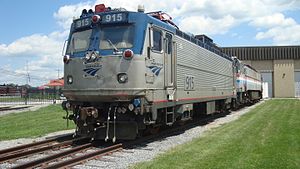EMD AEM-7

AEM-7 #915 on display at the Railroad Museum of Pennsylvania
|
|||||||||||||||||||||||||||||||||||||||||||||||||||
|
|||||||||||||||||||||||||||||||||||||||||||||||||||
|
|||||||||||||||||||||||||||||||||||||||||||||||||||
|
|||||||||||||||||||||||||||||||||||||||||||||||||||
|
|||||||||||||||||||||||||||||||||||||||||||||||||||
| Type and origin | |
|---|---|
| Power type | Electric |
| Builder | General Motors Electro-Motive Division |
| Build date | 1978–1988 |
| Total produced | 65 |
| Rebuilder | Alstom Transport |
| Rebuild date | 1999-2002 |
| Number rebuilt | 29 |
| Specifications | |
|---|---|
| AAR wheel arr. | B-B |
| UIC class | Bo'Bo' |
| Gauge | 4 ft 8 1⁄2 in (1,435 mm) standard gauge |
| Wheel diameter | 51 1⁄8 in (1,299 mm) |
| Minimum curve | 245 ft (75 m) / 23.4° (single unit) 265 ft (81 m) / 21.6° (coupled) |
| Wheelbase | 25 ft 7 1⁄16 in (7.80 m) (between truck centers) |
| Length | 51 ft 1 25⁄32 in (15.590 m) |
| Width | 10 ft 2 in (3.10 m) |
| Height | 14 ft 9.5 in (4.51 m) |
| Axle load | 51,225 lb (23,235 kg) |
| Adhesive weight | 100% |
| Loco weight | 204,900 lb (92,941 kg) max |
| Sandbox cap | 10.6 cubic feet (300 L) |
| Power supply | Catenary |
| Electric system(s) | |
| Current collection | Dual pantographs |
| Traction motors | ASEA LJH 108-5 (DC) Alstom 6 FXA 5856 (AC) |
| Head end power | 500 kilowatts (670 horsepower) (DC) 1,000 kilowatts (1,300 horsepower) (AC) |
| Transmission | 85:36 |
| MU working | yes |
| Train heating | Locomotive-supplied head-end power |
| Loco brake | Dynamic / Regenerative / Electropneumatic |
| Train brakes | Electropneumatic |
| Safety systems | ACSES II |
| Performance figures | |
|---|---|
| Maximum speed | 135 mph (217 km/h) (design) 125 mph (201 km/h) (operational) |
| Power output | AEM-7DC and AC: 5,100 kilowatts (6,800 horsepower) maximum at rail 4,320 kilowatts (5,790 horsepower) continuous at rail |
| Tractive effort | Starting Tractive Effort: 53,924 lbf (239.9 kN) (DC) 51,700 lbf (230.0 kN) to 43 mph (69 km/h) (AC) Continuous Tractive Effort: 30,000 lbf (133.4 kN) @ 77 mph (124 km/h) (DC) 39,500 lbf (175.7 kN) @ 65 mph (105 km/h) (AC) |
| Factor of adh. | ~ 3.85 |
| Loco brakeforce | 15,600 lbf (69.4 kN) (DC) 20,000 lbf (89.0 kN) (AC) |
| Career | |
|---|---|
| Numbers | |
| Nicknames | Toasters; Meatballs |
| Locale | Northeast Corridor, Keystone Corridor |
| Preserved | Amtrak #915 |
The AEM-7 is a twin-cab B-B electric locomotive that was used in the United States on the Northeast Corridor between Washington DC and Boston and the Keystone Corridor between Philadelphia and Harrisburg in Pennsylvania. They were built by Electro-Motive Division from 1978 to 1988. EMD manufactured 65 locomotives between 1978–1988; the majority of these were for Amtrak, other operators included MARC and SEPTA. Amtrak has retired their fleet in favor of the newer Siemens ACS-64, which entered service in 2014; MARC and SEPTA plan to replace theirs between 2017–2019.
Amtrak assumed control of almost all private sector intercity passenger rail service in the United States on May 1, 1971, with a mandate to reverse decades of decline. Amtrak retained approximately 184 of the 440 trains which had run the day before. To operate these trains, Amtrak inherited a fleet of 300 locomotives (electric and diesel) and 1190 passenger cars, most of which dated from the 1940s–1950s.
Operation on the electrified portion of the Northeast Corridor was split between the Budd Metroliner electric multiple units and PRR GG1 locomotives. The latter were over 35 years old and restricted to 85 mph (137 km/h). Amtrak sought a replacement, but no United States manufacturer offered an electric passenger locomotive. Importing and adapting a European locomotive would require a three-year lead time. With few other options, Amtrak turned to GE to adapt the E60 for passenger service. Unfortunately, the E60 proved unsuitable for speeds above 90 mph (145 km/h), leaving Amtrak once again in need of a permanent solution.
...
Wikipedia
